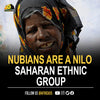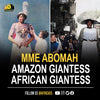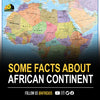Africa is now widely recognized as the birthplace of the Hominidae, the taxonomic family to which modern humans belong. Archaeological evidence indicates that the continent has been inhabited by humans and their forebears for some 4,000,000 years or more. Anatomically modern humans are believed to have appeared as early as 200,000 years ago in the eastern region of Africa. Somewhat later those early humans spread into northern Africa and the Middle East and, ultimately, to the rest of the world. Africa has the most physically varied populations in the world, from the tallest peoples to the shortest; body form and facial and other morphological features also vary widely. It is the continent with the greatest human genetic variation, reflecting its evolutionary role as the source of all human DNA.
When people think of skin color in Africa, most would think of darker skin but there is a huge amount of variation, ranging from skin as light to the darkest skin on a global level and everything in between. Well here is a shocker, there are many different completely natural African skin tones ranging from very dark to very light, from the Dinka of South Sudan to the San of South Africa respectively.Africans have the most diverse skin tones in the world. People in Africa have almost every skin colour on the planet. Populations of indigenous people in southern Africa like the San people carry a gene that causes lighter skin, and scientists have now identified the rapid evolution of this gene in recent human history.
Naturally blonde hair is often associated with white or Caucasian people. However, there are groups of dark skin people who have naturally blonde hair also. Some of these groups include the Aboriginal Australians (Aborigines) and the Melanesians. Similarly, the Solomon Island Melanesians have dark skin, blue eyes, and blonde hair. The children often have curly blonde hair which may turn darker when they get older. Blonde hair is also found in many of the women as well.
Africans are known to mostly have brown or black eyes while Caucasians are mostly known to have varieties of colors. However, contrary to the popular belief, having blue eyes is not limited to Asians or Europeans, a significant number of Africans are known to have blue eyes. “Originally, we all had brown eyes, but a genetic mutation affecting the OCA2 gene in our chromosomes resulted in the creation of a ‘switch’ which literally ‘turned off’ the ability to produce brown eyes.”
Many African people had broad noses characteristic of Africans, but the presence of narrow noses too is not reflective of non-African admixture. Narrow and even long noses are very common in East Africa and among some West Africans like the Fulani. Narrow noses are an evolutionary trait first adapted by people living in the Ethiopian highlands for 200,000 years, many thousands of years before any human left Africa.
The point is, a narrow and/or long nose on a Black African (including those in Ancient Kemet) is an indigenous trait from ancestors who lived in high altitudes such as Ethiopia and Rwanda.Therefore, the way we see the world today is biased since we always try to oppose Black to White and we wrongfully attribute all these features to the so called white people thinking that they are they ones who brought it to the world. In reality, there is no opposition to black because it is the root of everything. There is no white without Black. But there is Black without the existence of White. And it has actually been that way for 99,9% of the existence of the human race on this planet. There is no white race but only ONE Black race with numerous levels of melanin hence various genetic diversity.
References
1. Watson E, Forster P, Richards M, Bandelt HJ 1997. Mitochondrial footprints of human expansion in Africa. Am J Hum Genet 61: 691–704.
2. Vigilant L, Stoneking M, Harpending H, Hawkes K, Wilson AC 1991. African populations and the evolution of human mitochondrial DNA. Science 253: 1503–1507.
3. Tishkoff SA, Reed FA, Friedlaender FR, Ehret C, Ranciaro A, Froment A, Hirbo JB, Awomoyi AA, Bodo J-M, Doumbo O, et al. 2009. The genetic structure and history of Africans and African Americans. Science 324: 1035–1044.







